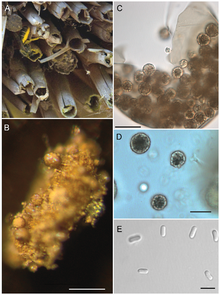| Ascosphaera | |
|---|---|

| |
| A) habitat. Phragmites reeds and female Chelostoma florisomne returning with pollen for her brood. B) fecal pellet of C. florisomne larva covered with spore cysts; pale spore balls are visible through the transparent spore cyst wall. C) close-up of spore cyst showing spore balls and smooth, unornamented spore cyst wall. D) spore balls. E) bacilliform ascospores. Scale bars: B = 200 µm, C = 50 µm, C = 10 µm, D = 15 µm, E = 10 µm. | |
| Scientific classification | |
| Domain: | Eukaryota |
| Kingdom: | Fungi |
| Division: | Ascomycota |
| Class: | Eurotiomycetes |
| Order: | Onygenales |
| Family: | Ascosphaeraceae |
| Genus: | Ascosphaera L.S.Olive & Spiltoir (1955) |
| Type species | |
| Ascosphaera apis (Maasen ex Claussen) L.S.Olive & Spiltoir (1955)
| |
| Synonyms | |
|
Pericystis Betts (1912)[1] | |
Ascosphaera is a genus of fungi in the family Ascosphaeraceae. It was described in 1955 by mycologists Charles F. Spiltoir and Lindsay S. Olive.[2] Members of the genus are insect pathogens. The type species, A. apis, causes chalkbrood disease in honey bees.[3] The reproductive ascospores of the fungus are produced within a unique structure, the spore cyst, or sporocyst.[4]
- ^ Cite error: The named reference
Betts 1912was invoked but never defined (see the help page). - ^ Cite error: The named reference
Spiltoir 1955was invoked but never defined (see the help page). - ^ Cite error: The named reference
Capinera 2008was invoked but never defined (see the help page). - ^ Wynns, A.A.; Jensen, A.B.; Eilenberg, J.; James, R. (2012), "Ascosphaera subglobosa, a new spore cyst fungus from North America associated with the solitary bee Megachile rotundata", Mycologia, 104 (1): 108–114, doi:10.3852/10-047, PMID 21828215, S2CID 26872248